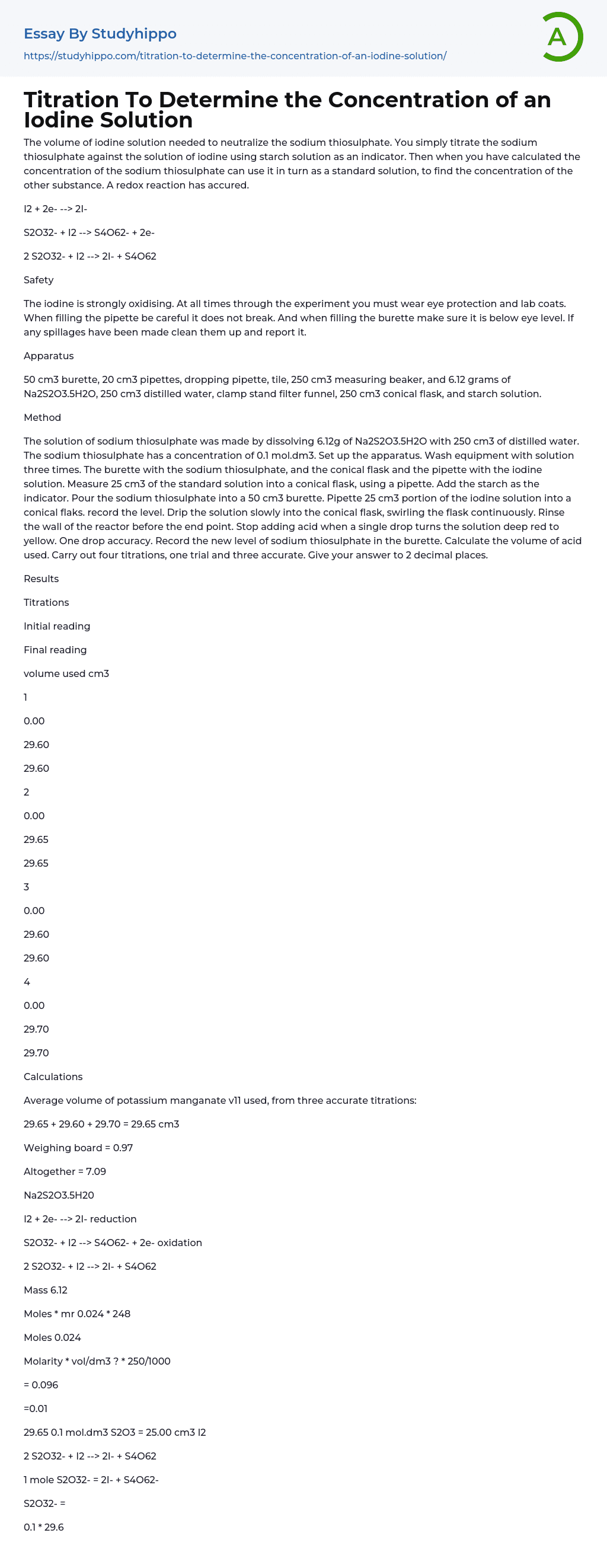

Titration To Determine the Concentration of an Iodine Solution Essay Example
The volume of iodine solution needed to neutralize the sodium thiosulphate. You simply titrate the sodium thiosulphate against the solution of iodine using starch solution as an indicator. Then when you have calculated the concentration of the sodium thiosulphate can use it in turn as a standard solution, to find the concentration of the other substance. A redox reaction has accured.
Safety
The iodine is strongly oxidising. At all times through the experiment you must wear eye protection and lab coats. When filling the pipette be careful it does not break. And when filling the burette make sure it is below eye level. If any spillages have been made clean them up and report it.
Apparatus
50 cm3 burette, 20 cm3 pipettes, dropping pipette, tile, 250 cm3 measuring beaker, and 6.12 grams of Na2S2O3.5H2O, 250 cm3 distilled water, cla
...mp stand filter funnel, 250 cm3 conical flask, and starch solution.
Method
The solution of sodium thiosulphate was made by dissolving 6.12g of Na2S2O3.5H2O with 250 cm3 of distilled water. The sodium thiosulphate has a concentration of 0.1 mol.dm3. Set up the apparatus. Wash equipment with solution three times. The burette with the sodium thiosulphate, and the conical flask and the pipette with the iodine solution. Measure 25 cm3 of the standard solution into a conical flask, using a pipette. Add the starch as the indicator. Pour the sodium thiosulphate into a 50 cm3 burette. Pipette 25 cm3 portion of the iodine solution into a conical flaks. record the level. Drip the solution slowly into the conical flask, swirling the flask continuously. Rinse the wall of the reactor before the end point. Stop adding acid when a single drop turns the solution deep
red to yellow. One drop accuracy. Record the new level of sodium thiosulphate in the burette. Calculate the volume of acid used. Carry out four titrations, one trial and three accurate. Give your answer to 2 decimal places.
Discussion
The end point might be different due to human error, they might have added a couple of extra drops or they might not have added enough drops. Or they might have lost some of the solution. Another factor instrument error which can be built in, due to it will not give a precise point. The pipette could have been a different scale e.g. 10, 15, 25 cm3 etc. which might have had some sodium hydroxide left in its tip. The reading could not be exactly clear due human usage of the instrument time after time. Pr�cis accuracy. The numbers could have been blurred so you can not read it to. The meniscus of the solutions could be out a little. We could have lost some of the solution when we were transferring it from the pipette to the conical flask. It could have remained on the side of the pipette and the conical flask. We could not collect all the solutions no matter how hard we tried. Due to equipment error.
For the burette.
This shows that the equipment are not absolute accurate. Another factor could have been the air around us. Or standing near the window and the outside temperature could have its effect.
Other instruments could be used which have a better accuracy point. More sophisticated measuring equipment could also be another point to notice.
Conclusion
The morality of the iodine solution was 0.0593 moldm3. The results were close together and
the indicator changed quickly at the end point. If you were to repeat this experiment you could make it better by using a different indicator instead of starch, or using a different concentration of sodium thiosulphate.
- Acid essays
- Calcium essays
- Carbohydrate essays
- Carbon essays
- Chemical Bond essays
- Chemical Reaction essays
- Chemical reactions essays
- Chromatography essays
- Concentration essays
- Copper essays
- Diffusion essays
- Ethanol essays
- Hydrogen essays
- Organic Chemistry essays
- Osmosis essays
- Periodic Table essays
- Ph essays
- Salt essays
- Sodium essays
- Titration essays



